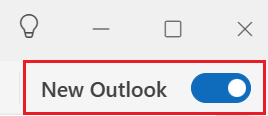Exporter ou sauvegarder mes contacts, mon calendrier, mes emails et mes tâches
Créez un fichier de sauvegarde Outlook pour enregistrer et exporter vos emails, contacts, informations de calendrier et tâches. Vous pouvez alors importer votre sauvegarde dans un nouveau plan de messagerie, un service de messagerie ou une autre version d’Outlook. L’exportation n’inclut pas les métadonnées telles que les propriétés du dossier (affichage, autorisations et paramètres d’archivage automatique), les règles de message et les listes d’expéditeurs bloqués. Notez que Microsoft ne prend plus en charge les versions d’Outlook antérieures à 2016.
Sélectionnez l’onglet approprié en fonction de la plate-forme de messagerie que vous utilisez.
- Connectez-vous à Outlook sur le Web. Utilisez votre adresse email et votre mot de passe Microsoft 365 (votre nom d’utilisateur et votre mot de passe GoDaddy ne fonctionneront pas).
- Sélectionnez
 Personnes tout à gauche de la page.
Personnes tout à gauche de la page. - Sélectionnez Gérer les contacts, puis Exporter les contacts.
- Choisissez si vous voulez exporter tous les contacts ou uniquement les contacts d'un dossier spécifique, puis sélectionnez Exporter.
Vos contacts seront enregistrés dans un fichier .csv, que vous pourrez importer dans d’autres applications de messagerie (comme Gmail) ou d’autres versions d’Outlook.
- Ouvrez Outlook.
- Si vous êtes dans le nouvel Outlook, revenez à la version antérieure. Dans le coin supérieur droit, désactivez l’option Nouvel Outlook. Vous devrez peut-être confirmer que vous souhaitez revenir à la version antérieure.

- En haut à gauche, sélectionnez Fichiers.
- Sélectionnez Ouvrir et exporter, puis Importer/Exporter.
- Sélectionnez Exporter vers un fichier, puis Suivant.
- Sélectionnez Fichier de données Outlook (.pst) puis ,Suivant.
- Pour exporter la totalité de la boîte aux lettres, sélectionnez le nom du compte mail avant de passer à l’étape suivante. Pour exporter uniquement votre calendrier, vos contacts ou vos tâches, sélectionnez le dossier correspondant. Vous ne pouvez exporter qu’un seul dossier à la fois, vous devrez donc répéter ces étapes pour chacun (contacts, calendriers, tâches).
- Assurez-vous que la case en regard de l’option Inclure les sous-dossiers est cochée, puis sélectionnez Suivant.
- Pour sélectionner l’emplacement dans lequel enregistrer le fichier de données Outlook (.pst), sélectionnez Parcourir. Entrez un nom de fichier, puis sélectionnez OK.
- En cas d’exportation vers un fichier de données Outlook (.pst) existant, sous Options, spécifiez la marche à suivre si des éléments exportés existent déjà dans le fichier.

- Sélectionnez Terminer.
- L’exportation démarre immédiatement, sauf dans le cas de l’un des scénarios suivants :
- Lorsque la boîte de dialogue Créer un fichier de données Outlook s’affiche, entrez le mot de passe dans les zones Mot de passe et Vérifier le mot de passe, puis sélectionnez OK. Sinon, pour continuer sans configurer un mot de passe, laissez les champs de mot de passe vides, puis sélectionnez OK.
- En cas d’exportation vers un fichier de données Outlook (.pst) existant protégé par mot de passe, dans la boîte de dialogue Mot de passe du fichier de données Outlook, entrez le mot de passe, puis sélectionnez OK.
- Ouvrez Outlook.
- Si vous êtes dans la nouvelle version d’Outlook, revenez à la version classique. Sélectionnez Outlook, puis Outlook classique. Vous devrez peut-être confirmer que vous souhaitez revenir à la version antérieure.

- Sélectionnez Fichier, puis Exporter. La fenêtre Exporter vers un fichier archive (.olm) s’ouvre.
- Si Exporter n’apparaît pas, sélectionnez Outils, puis Exporter à la place.
- Sélectionnez le ou les éléments à exporter. Par défaut, tous les éléments sont sélectionnés.
- Pour exporter l’un de ces dossiers individuellement, sélectionnez la case à cocher en regard de chaque élément.

- Sélectionnez Continuer.
- Choisissez un emplacement et un nom pour le fichier, puis sélectionnez Enregistrer. Vos éléments vont être exportés.
- Sélectionnez Terminer.
Étape connexe
- Maintenant que vos données Outlook sont exportées dans un fichier de sauvegarde, vous pouvez les importer dans Outlook.
En savoir plus
- Découvrez comment exporter un calendrier vers un fichier .ics depuis Microsoft.
- Vous trouverez plus d’informations sur l’exportation et l’importation de fichiers dans Outlook auprès de Microsoft.
- Consultez cet article d’Apple pour savoir comment importer et exporter des boîtes aux lettres dans Apple Mail sur Mac.